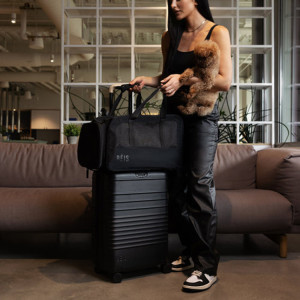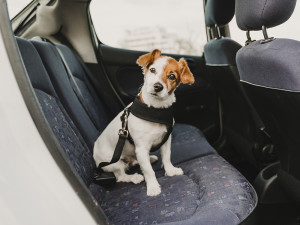Is Your Dog Ready To Be America’s Next Top Bag-Dog?
Trainer Rob Haussmann on how to safely bring your pup on the subway.

share article

Your pet wants you to read our newsletter. (Then give them a treat.)
In 2016, New York’s Metro Transit Authority (MTA) introduced a new regulation aimed at significantly minimizing the prevalence of dogs on their subways. Specifically, itstated thatopens in a new tab “no person may bring any animal on or into any conveyance or facility unless enclosed in a container and carried in a manner which would not annoy other passengers.” But similar to when they are faced with food-scavenging rats, drunk people urinating behind the platform, or seeminglyradioactive oozeopens in a new tab, New York commuters causally found a way around the mess.
As innate rebels, NYC pet parents quickly devised a collective loophole by generously stretching the definition of “enclosed in a container.” While some passengers accompanied by smaller dogs were able to use actual pet carriersopens in a new tab, as the MTA ruling intended, others with medium-to-large-sized animals got creative. Pictures of dogs being sneaked onto trains in totes, backpacks, duffle bags, or even plastic bags with holes cut out for the legs became a viral phenomenon.
One Instagram account,@bagdogsopens in a new tab, started cataloging these images and as of today has over 118k followers. Possibly its most popular post included a dog with a loosely fittedfurniture store bagopens in a new tab wrapped around them. “The one that people love the most is the IKEA bag with foot holes cut out. That one’s definitely the wildest because the dog is not even being carried. They’re just walking and happen to have a bag wrapped around them,” the anonymous manager of @bagdogs tells The Wildest.
Images like that have only escalated efforts to duck the MTA’s regulation. While the bagdog’s account operator notes that ostensibly the number of dogs being brought onto the subway has increased since the ruling was put into effect, they add that this has not been reflected in how often or strictly it’s enforced. “I don’t know anybody who has ever gotten a ticket for it and I know people who walk their dogs on the train. Besides, it’s way more comfortable to ride the train with a bag on your shoulder than to sit down with a dog on your lap,” the account’s creator says.
I’d love to chalk this up to cops being unable to resist the appeal of cute dogs in any scenario, but it’s likely more to do with the minimal sway of this regulation. Ultimately, the rarely enforced fee for violating this ruling is a mere $25. So, contrary to the trendy, albeit delightful, pics of makeshift carriers, sneaking your pup onto the subway is fairly easy. The bigger concern should be how to do it safely — if at all.
Should your dog be a subway passenger?
“I understand why the restrictions exist. The subway is a crowded, loud, and often overwhelming environment and dogs may be stressed and less predictable under those conditions,” Robert Haussmann, dog traineropens in a new tab and co-founder ofDogboy NYCopens in a new tab, says. As a New York local, Haussmann has a unique understanding of the situation and offers some insights into how best to approach canine train travel.
But before broaching the tracks, it’s important to contemplate whether your dog is up for the challenge. “I think it is a shining example of the ingenuity, creativity, and giant cojones of the average New Yorker,” Haussmann adds. “At the same time, I have seen dogs on the subway — even ones that fit in carriers — who are shaking with fear and whose owners are not doing them any favors by bringing them along.” He explains that the only dogs who should be brought onto public transit need to be well-socialized to both humans and animals. Not to mention, any anxious pupsopens in a new tab who struggle with crowds, are sensitive to noise, or are unfamiliar with vibrations should be left with a sitter.
More than anything, it’s crucial to not overstimulate your dog. “If you are not 100 percent sure this will be a safe and pleasant experience for your dog, come up with another plan,” Haussmann says. He adds: “Dogs who are sick, unpredictable, not very good with strangers (especially kids), noise sensitive, easily overwhelmed, etc., should stay home. Common sense plays a big role. Even if you really want to bring your pup to the party, think to yourself if it benefits them or adds unnecessary stress.”
That being said, there are plenty of pups who are able to safely ride along on the daily commute and what they are held in can make all the difference in finalizing a positive experience. Luckily, if your dog is smaller, comfortable with loud sounds, and not spooked by crowds, there are plenty of carrier optionsopens in a new tab without resorting to IKEA bags.
You can get creative, but is your dog comfy?
The ordeal might be a taller task for medium-to-large-sized pups — and not just in terms of logistics. “Getting a large-breed dog comfortable in a travel crate is not that hard. The hard part is getting them comfortable being carried in one,” Haussmann explains. He recommends taking the time to practice using the carrier with your dog before venturing out to the subway by zipping them in and carrying them around in a controlled environment. Additionally, Haussmann notes that the more creative options you may see circulating online might not be ideal for the animals in general.
Now, if you run into other issues like difficulty lifting your dog over the turnstile, Haussmann recommends asking an MTA worker to open the emergency or handicapped door. In all likelihood, they’re not going to deny you access even if the carrier doesn’t pass their regulation. Again, the most important aspect of this is your pet’s comfort. Before attempting to bring them along, check in with your dog and consider whether they’d enjoy this experience.
“Regardless of size, know your dog well enough to advocate for their needs,” Haussmann says. “If your dog will be stressed on the train don’t force it. Think of who this is benefitting, and if it makes sense from a practical and emotional level to bring your pooch along. In a big mean city like New York, it pays to show your best friend a little kindness.”

Sean Zucker
Sean Zucker is a writer whose work has been featured in Points In Case, The Daily Drunk, Posty, and WellWell. He has an adopted Pit Bull named Banshee whose work has been featured on the kitchen floor and whose behavioral issues rival his own.
Related articles
![two small puppies play on a beach]()
Here’s Why You Need to Socialize Your Dog ASAP
Waiting until full vaccination to socialize can cause huge problems for your pup.
![collage of NYC dog friendly places]() opens in a new tab
opens in a new tabThe Dog-Friendly New York City Guide For Your Favorite City Slicker
Whether you’re brunching, barhopping, or looking for a place to crash in NYC, your dog deserves to come with you. Here are all the spots ready with bowls of water, treats, ear scratches, and open-door policies for your best pal.
![dogs at dog park drinking water and playing in pool]() opens in a new tab
opens in a new tabDog Park Etiquette: Dog Park Dos and Don’ts
New kid on the block? Follow this trainer’s tips before letting your pet run wild.
![A woman standing next to a suitcase with a dog carrier on top while holding her dog.]() opens in a new tab
opens in a new tabThe Best Dog Carriers For Planes, Trains, and Automobiles
Whether you’re driving cross country or flying internationally, your pup can comfortably tag along.
![Dog seat-belted in a car]() opens in a new tab
opens in a new tab19 of the Best Car Travel Gear for Dogs
All the essentials you need to hit the road with your co-pilot, from dog seatbelts to crash-tested carriers.




